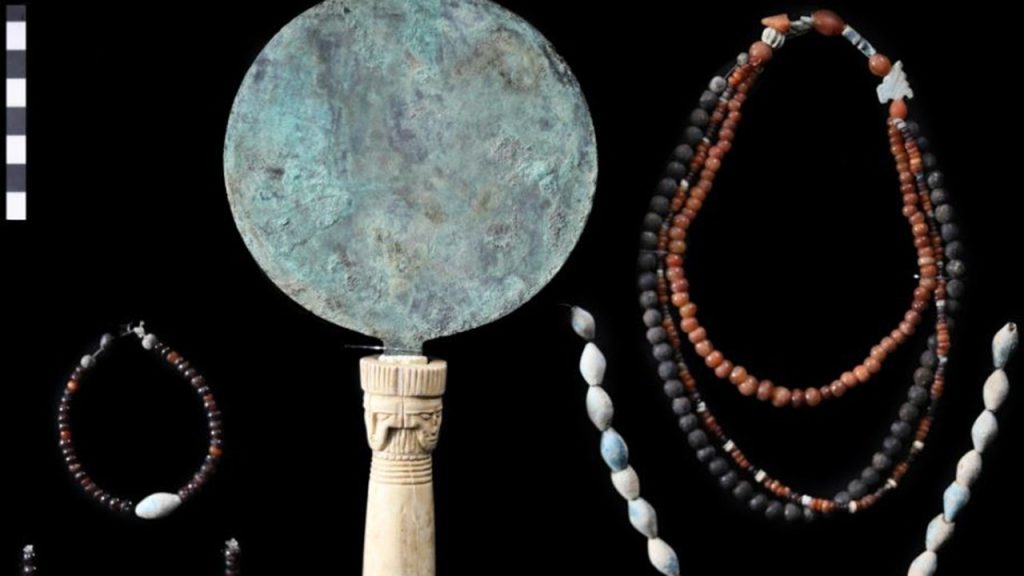Archaeologists working on a joint American and Egyptian expedition near Luxor have discovered a 4,000-year-old Middle Kingdom tomb containing several intact burials. Along with the sealed burials, the team found a variety of items, including jewelry, mirrors, scarab rings, and girdles made of carnelian, garnet, faience, and feldspar. One of the mirrors had a lotiform handle, while the other featured a rare design of a four-faced Hathor presenting as a woman with austere features. A necklace found in one of the tombs was made of amethyst and agate beads, with a hippo head amulet.
In addition to the jewelry, the researchers uncovered a green-blue glazed faience fertility figurine, which they described as an “important find.” The figurine was well-modeled and decorated with jewelry and lozenge markings. An interesting detail was that the figurine had holes for attaching “hair,” with almost 4,000 mud beads found nearby as the original hair. The wooden coffins and fine linens inside the tomb were mostly destroyed by ancient floods. The tomb contained the skeletons of five women, two men, and three children, indicating that it likely belonged to a family.
The tomb, located in the South Asasif necropolis near the Temple of Hatshepsut on the Nile’s West Bank in Luxor, is the first Middle Kingdom tomb discovered in the area. This discovery has altered the history of the South Asasif necropolis and now places it within the larger Theban Middle Kingdom necropolis. The findings provide insight into burial practices and rituals of the Theban necropolis during the Middle Kingdom, along with a well-preserved collection of exquisitely crafted jewelry. This significant discovery contributes to our understanding of the ancient Egyptian civilization.
Luxor in southern Egypt has been a significant site for archaeological discoveries, with hundreds of tombs uncovered over the years. The most famous resident found in the area is Tutankhamen, an Egyptian pharaoh who ruled around 1332-1323 B.C. His tomb, discovered in 1922, contained a wealth of treasures that provided valuable insights into ancient Egyptian culture and beliefs. The discovery of the Middle Kingdom tomb near Luxor adds to the rich archaeological history of the region and offers a glimpse into the lives and burial practices of ancient Egyptians during that time period.
The South Asasif Conservation Project, led by Dr. Elena Pischikova, has made remarkable discoveries in the South Asasif necropolis. The team’s efforts have shed light on the burial practices and rituals of ancient Egyptians during the Middle Kingdom. The well-preserved jewelry, intricate figurines, and other artifacts found in the tomb provide valuable information about the cultural and artistic practices of the time. This latest discovery highlights the importance of continued archaeological research in Luxor and the potential for uncovering more secrets of Egypt’s ancient past.
Overall, the discovery of the 4,000-year-old Middle Kingdom tomb near Luxor has provided archaeologists with a unique glimpse into the lives and burial practices of ancient Egyptians. The artifacts found in the tomb, including jewelry, figurines, and burial goods, offer valuable insights into the culture, artistry, and beliefs of the Middle Kingdom period. This significant discovery adds to the rich archaeological history of Luxor and underscores the importance of ongoing research and exploration in uncovering the mysteries of Egypt’s ancient past.


